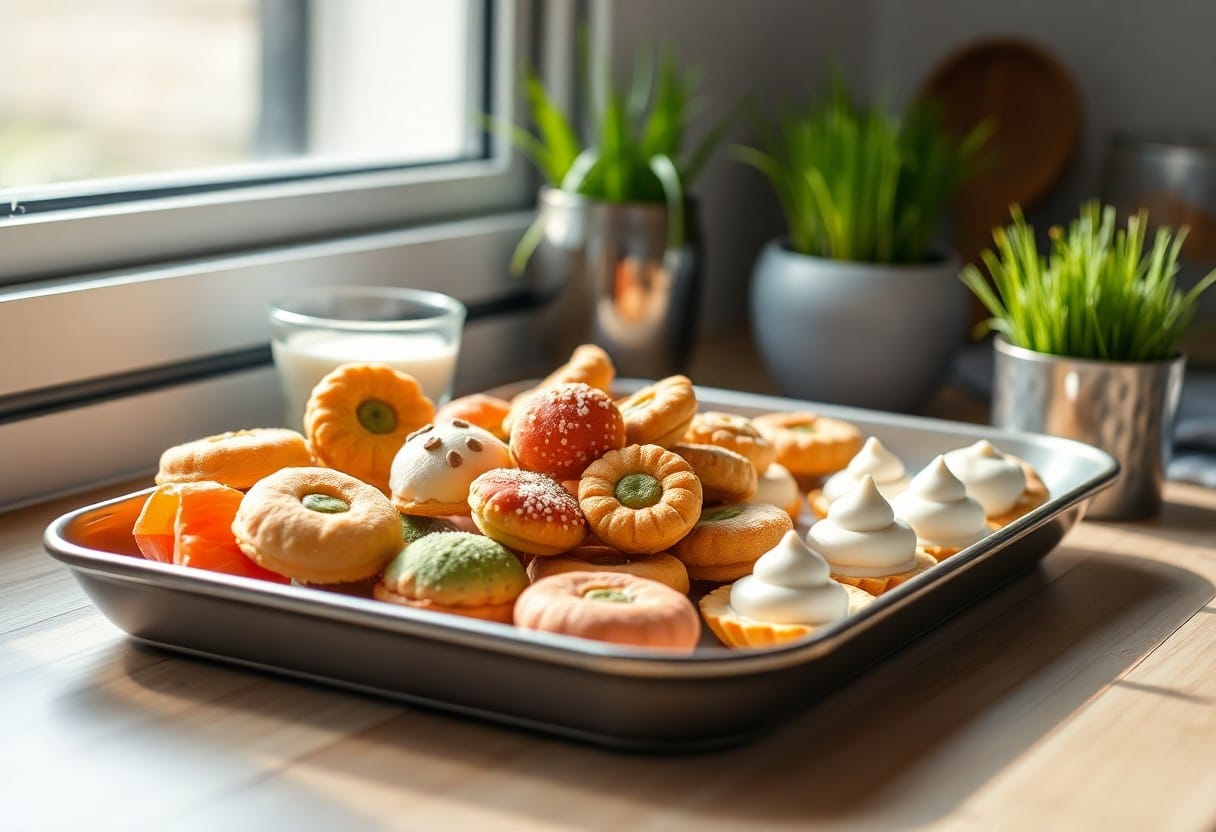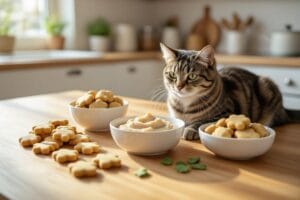You can elevate your cat’s diet by creating nutritious and tasty treats that cater to your feline’s unique preferences and needs. Whether your cat prefers fish, chicken, or even veggies, making these healthy snacks is both simple and rewarding. By choosing natural ingredients, you’ll ensure your cat stays away from harmful additives often found in store-bought treats. In this blog post, you’ll discover easy recipes designed for every type of feline, helping you to bond with your pet while providing them with wholesome goodies they will love.

Key Takeaways:
- Homemade cat treats can be tailored to meet the dietary needs and preferences of different feline companions, ensuring both nutrition and enjoyment.
- Using simple, wholesome ingredients allows pet owners to control what goes into their cat’s treats, reducing the risk of allergens and artificial additives.
- Engaging in the process of making treats can strengthen the bond between pet owners and their cats, while also providing a fun and rewarding experience.
Decoding Feline Nutrition: What Cats Really Need
Understanding feline nutrition goes beyond just providing food; it involves recognizing your cat’s unique dietary needs based on their physiology, age, and activity level. Cats are obligate carnivores, which means they require a diet high in animal protein to thrive. Ensuring that your cat receives the right balance of nutrients not only contributes to their overall health but also enhances their energy levels, coat condition, and longevity. Making informed choices about what goes into their treats can significantly impact their well-being.
Essential Nutrients for Cat Health
Your cat’s diet should be rich in several vital nutrients including proteins, fats, vitamins, and minerals. Proteins are necessary for muscle development and energy, while fats provide vital fatty acids for skin and coat health. Necessary vitamins like A, D, E, and K play vital roles in metabolic processes, and minerals such as calcium and phosphorus are crucial for bone density. This combination ensures your feline friend remains vibrant and active.
Understanding Dietary Requirements by Age and Lifestyle
The dietary needs of your cat will evolve as they progress through different life stages. For instance, kittens need higher levels of protein and fat to support their rapid growth, while senior cats may require specialized diets that address issues like weight management or joint health. Additionally, factors like your cat’s activity level and whether they are indoor or outdoor cats can influence their nutritional requirements. Tailoring their diet accordingly can promote optimal health throughout their life.
For example, a young, playful kitten might benefit from a high-calorie diet rich in protein to support their playful antics, while an older, less active cat may require a lower-calorie food to prevent obesity. Outdoor cats need more energy-dense nutrition because their activity levels are higher, while indoor cats may require a balanced diet that limits excess weight gain. By tailoring your cat’s food to meet their age and lifestyle needs, you can help ensure they live a healthier, longer life.
Crafting the Perfect Treat: Ingredients that Matter
Creating the ideal cat treat revolves around selecting the right ingredients, ensuring health benefits without compromising taste. By focusing on high-quality proteins, incorporating healthy carbohydrates, and including good fats, you can cater to your feline’s nutritional needs while offering them flavors they’ll adore. Each ingredient plays a significant role in promoting overall health, energy, and well-being, allowing you to create treats that not only satisfy your cat’s cravings but also enhance their diet.
Selecting High-Quality Proteins
Proteins serve as the foundation of your cat’s diet, which is why using high-quality sources is vital. Options like chicken, turkey, and fish not only provide vital amino acids but also cater to your feline’s natural hunting instincts. Ensuring the meat is fresh and free from fillers boosts the nutritional value, promoting healthy muscle development and vitality, keeping your cat energized and active throughout the day.
Incorporating Healthy Carbohydrates and Fats
Healthy carbohydrates and fats contribute to the overall nutritional profile of your treats. Ingredients like pumpkin, sweet potato, and oats offer digestible carbs that provide energy. Meanwhile, healthy fats from sources such as fish oil supply omega-3 and omega-6 fatty acids, which aid in maintaining a shiny coat and healthy skin. A balanced combination of these elements not only satisfies your cat’s taste preferences but also serves to support their digestive health and provides lasting energy throughout playtime.
Incorporating carbohydrates and fats into your treat recipes allows for a more balanced approach to a cat’s diet. Carbohydrates, particularly those rich in fiber, help regulate digestion and can prevent issues such as constipation. For example, pumpkin is a great source of fiber while also adding a hint of sweetness. On the other hand, healthy fats are vital for cognitive function and coat health. By blending wholesome carbs with nourishing fats, you create delicious treats that not only taste great but also align with your cat’s nutritional needs.
Flavor Profiles that Felines Crave
Understanding the flavors that resonate with your cat’s palate can elevate treat-making to a whole new level. Cats are obligate carnivores, which means they thrive on the flavors derived from meat, but they also enjoy a variety of other tastes. Common favorites include chicken, turkey, and fish. Additionally, some cats are fond of cheese and liver, making these excellent options to enhance the flavor profile of your homemade treats. Pay attention to your cat’s reactions; their favorite flavors can guide your experiments in the kitchen.
Experimenting with Cat-Approved Flavors
Creativity in the kitchen can yield delightful results when crafting treats. Incorporate flavor boosters like tuna juice, chicken broth, or catnip to captivate your feline’s interest. By mixing different protein sources or adding small amounts of vegetables, like pureed pumpkin, you can offer unique combinations that will surely surprise your cat. Always observe their preferences, as each cat has distinct likes and dislikes that can guide your next batch.
Balancing Taste with Nutrition
Creating delicious cat treats doesn’t mean sacrificing nutritional value. You can achieve a balance by utilizing wholesome ingredients that provide crucial nutrients while still delighting your cat’s taste buds. For instance, adding oats or brown rice can serve as healthy fillers while incorporating protein-rich ingredients like fish or chicken ensures your treats maintain their appeal. Additionally, incorporating omega-3 fatty acids from fish can contribute to a luscious coat and overall health.
When you balance taste with nutrition, consider that your cat’s overall well-being remains the priority. Using high-quality, natural ingredients prevents empty calories often found in commercial treats. For example, incorporating carrots for fiber or salmon for omega-3s not only enhances flavor but also boosts health benefits. Mapping out a recipe with a good protein base followed by nutritious add-ins will create treats your cat loves while supporting their health, ensuring every bite is both tasty and beneficial.
Step-by-Step Recipes: Tailored Treats for Every Feline
Creating homemade treats gives you the flexibility to tailor recipes specifically for your cat’s unique preferences and dietary needs. These step-by-step recipes will allow you to easily whip up delicious, nutritious snacks that your feline will adore. From simple bites for discerning eaters to wholesome options designed for dietary restrictions, you’ll find the perfect treat to satisfy your kitty.
| Recipe Type | Key Ingredients |
|---|---|
| Picky Eaters | Tuna, chicken broth, catnip |
| Dietary Restrictions | Sweet potato, pumpkin, limited protein sources |
Recipes for Picky Eaters
For those feline connoisseurs who turn their noses up at commercial treats, crafting a homemade option can entice even the most discerning taste buds. Combine high-quality tuna with a splash of chicken broth for moisture and flavor. Add a dash of catnip for an irresistible touch, shaping the mixture into small, irresistible morsels. Baking these treats at a low temperature preserves the flavor while ensuring they remain soft for easy chewing.
Wholesome Options for Cats with Dietary Restrictions
Crafting treats for cats that require special dietary considerations can be a rewarding endeavor. Utilizing ingredients like sweet potatoes and pumpkin can provide vital vitamins while being gentle on their systems. Incorporate limited protein sources, such as pureed chicken or turkey, to cater to those with sensitivities. Always consult with your veterinarian to tailor recipes to your cat’s specific dietary needs, ensuring wellness while delighting their taste buds.
For cats with dietary restrictions, it’s vital to consider both flavor and nutrition. Incorporating ingredients like quinoa or brown rice can offer additional fiber, while balancing protein choices helps avoid allergens. Opt for homemade meals that allow you to monitor each ingredient, ensuring your pet enjoys the best of both worlds—delicious flavor and a healthful diet. Formulate your treats based on your vet’s advice, allowing you to create truly personalized and nourishing options for your feline friend.
Baking or No-Bake? Choosing Your Method
The choice between baking or no-bake treats often depends on your preference and the ingredients you have on hand. Baking usually results in a firmer texture that can be stored longer, while no-bake options are quick and easy, retaining maximum flavor and nutrients. Consider your schedule and your feline’s tastes, and you’ll find the method that works best for you and your furry friend.
Pros and Cons of Different Preparation Styles
Pros and Cons
| Preparation Style | Pros & Cons |
|---|---|
| Baking | ✔️ Longer shelf life ❌ Requires a preheated oven |
| No-Bake | ✔️ Quick to prepare ❌ May not last as long |
| Baking | ✔️ Crisp texture ❌ Can dry out if overcooked |
| No-Bake | ✔️ Retains nutrients ❌ Might be sticky or crumbly |
| Baking | ✔️ Versatile flavors ❌ More steps involved |
| No-Bake | ✔️ Minimal cleanup ❌ Limited flavor depth |
| Baking | ✔️ Can be made in batches ❌ Requires cooling time |
| No-Bake | ✔️ Ideal for last-minute treats ❌ Often less structured |
Storage and Freshness Tips for Homemade Treats
To keep your homemade cat treats fresh and tasty, store them in an airtight container in a cool, dry place. For extended freshness, consider refrigeration, especially for no-bake treats. Always label your containers with the date made, so you know when to replace them.
- Store treats in an airtight container to lock in freshness.
- Consider refrigeration for treats made with perishable ingredients.
- Label your containers with the date made for easy tracking.
- Check for signs of spoilage before serving to your cat.
For the best results, utilize a variety of storage solutions. A fridge can keep more sensitive treats fresh longer, while a cool pantry may suffice for baked goods. Consider using silica gel packets in your containers to absorb moisture and keep treats dry. Recognizing the storage needs of your treats will ensure your feline friends enjoy the nutritious snacks you’ve lovingly prepared.
- Utilize a cool pantry for low-moisture baked treats.
- Invest in silica gel packets for moisture management.
- Opt for clear labels to track freshness easily.
- Be attentive to storage conditions that might affect treat quality.
Summing up
The journey to crafting nutritious and tasty cat treats for your feline friend is both rewarding and enjoyable. By customizing recipes to suit each cat’s dietary needs and preferences, you not only enhance their health but also strengthen your bond. Experimenting with different ingredients will lead to discovering what your cat loves most, ensuring they receive only the best. With your creativity and care, you can provide your beloved pet with treats that are both delicious and wholesome.
FAQ
Q: What ingredients are typically used to make nutritious cat treats?
A: When creating your own cat treats, it’s important to choose ingredients that are beneficial for your feline friend. Common ingredients include high-quality proteins like chicken, turkey, or fish, which are vital for a cat’s diet. You can also use whole grains such as oats or brown rice for added fiber. Vegetables like sweet potatoes or carrots can provide vitamins and minerals, while eggs offer protein and healthy fats. Additionally, incorporating cat-safe herbs such as catnip or parsley can enhance both the flavor and nutritional value of the treats.
Q: How can I ensure the treats are safe for my cat?
A: Ensuring the safety of homemade cat treats involves using only cat-friendly ingredients and avoiding common toxic foods. Always double-check that the ingredients you are using are safe for cats, as certain foods like onions, garlic, chocolate, and grapes can be harmful. It’s also recommended to consult with your veterinarian about any new ingredients you plan to introduce into your cat’s diet, especially if your cat has existing health conditions or dietary restrictions. Finally, remember to introduce any new treats gradually to monitor for any adverse reactions.
Q: How should I store homemade cat treats to maintain freshness?
A: To keep your homemade cat treats fresh, store them in an airtight container in a cool, dry place. For longer shelf life, you can refrigerate them, depending on the ingredients used. Some treats may also be suitable for freezing; this is particularly helpful for larger batches. Always label the containers with the date they were made, and try to use them within a month or two for the best taste and nutrients. Ensure to check for any signs of spoilage before feeding them to your cat.











